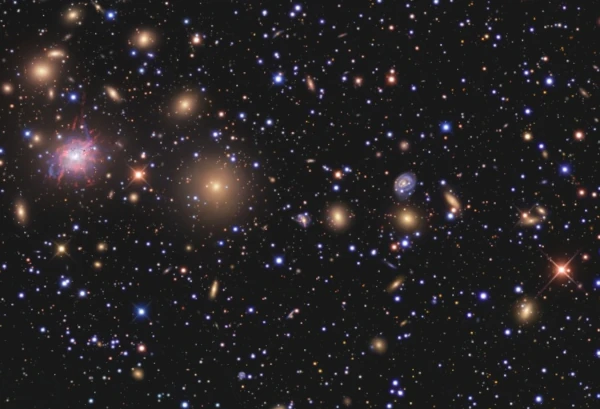
Image description: This celestial landscape of the Perseus cluster is filled with thousands of colorful elliptical and lenticular galaxies located nearly 250 million light-years away from us. Source APOD.
How can we explain that in such a vast universe, galaxies are relatively close to each other?
In our galaxy cluster (Local Group), the diameter of the Milky Way is about 100,000 light-years (ly). The Local Group, our "cosmic neighborhood," is a collection of about sixty galaxies, of which the Milky Way is a part. The main members of the Local Group are the Andromeda Galaxy, the Triangulum, the Large and Small Magellanic Clouds, and many dwarf galaxies (Canis Major, Barnard, Fornax, Carina, Leo, etc.).
• The Andromeda Galaxy (M31) is located about 2.5 million light-years away, which is 25 times the diameter of the Milky Way.
• The Triangulum Galaxy (M33) is located about 2.7 million light-years away, 2.7 times the diameter of the Milky Way.
• The Large Magellanic Cloud is located about 163,000 light-years away, 1.63 times the diameter of the Milky Way.
• The Small Magellanic Cloud is located about 200,000 light-years away, 2 times the diameter of the Milky Way.
These proportions show that galaxies in a galaxy cluster are relatively close to each other.
Note: Andromeda is on a collision course with the Milky Way. The two galaxies are expected to merge in about 4 to 5 billion years. This motion is primarily due to the mutual gravitational force of the two galaxies.
In a galaxy like the Milky Way, stars are separated by enormous distances compared to their size. For example, our Sun is located about 4.24 light-years from the nearest star, Proxima Centauri, while the diameter of the Sun itself is about 1.4 million km. This represents an enormous separation ratio, about 28 million times its diameter.
The relative concentration of galaxies in such a vast universe is an apparent puzzle that finds its explanation in the very foundations of cosmology and astrophysics.
After the Big Bang, matter in the universe was distributed relatively homogeneously. However, small fluctuations in matter density allowed certain regions to gravitationally collapse to form denser structures. The non-uniform distribution of matter in the universe, especially in the form of dark matter, induces large-scale gravitational instabilities that favor the formation of cosmic structures such as galaxy clusters. The clustering of galaxies explains their relative proximity.
The vastness of the molecular clouds from which stars form plays a crucial role in the relative distances between stars within galaxies. These clouds can be very large, with sizes of several light-years. Additionally, there are vast, less dense regions that do not form stars. Stars are relatively low-mass objects, confined by the collective gravity of the galaxy. Thus, they do not have the "freedom" to move through the universe as galaxies do in clusters. Although newly forming stars can create gravitationally bound star clusters, in these clusters, the stars are not close to each other; they can be separated by distances of up to several parsecs (about 3.26 light-years).
It may seem paradoxical that galaxies are relatively close to each other while the stars within the same galaxy are separated by immense distances relative to their size.
Dark matter, an invisible substance that interacts gravitationally with ordinary matter, constitutes the majority of the mass of the universe. Its uneven distribution has influenced the formation of cosmic structures by attracting visible matter to the densest regions. This explains why galaxies are not scattered randomly, but rather grouped into islands within a vast ocean of dark matter.
Galactic gravity gives stars a bounded trajectory, preventing them from freely approaching each other.